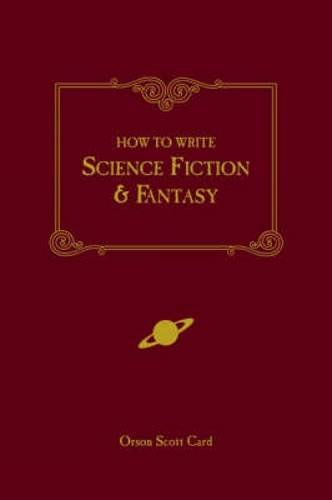
![]() How to Write Science Fiction & Fantasy by Orson Scott Card
How to Write Science Fiction & Fantasy by Orson Scott Card
Orson Scott Card is an award-winning author of dozens of science fiction and fantasy books, including the Hugo and Nebula award winning Ender’s Game. So who else would you turn to for instruction on how to write a science fiction and fantasy novel? I’m working on a novel — isn’t everyone these days? — and picked up How to Write Science Fiction and Fantasy for some instruction. I’m used to writing for an academic audience, so bridging the chasm between peer-reviewed journals and publicly read books is a big step for me. I have to say, though, that I’m not sure this book is really worth all the kudos it has in the writing community, and I think that’s mostly because it hasn’t been updated. The original publication date is 1990. Whole genres of fantasy have come out since 1990, not to mention the advent of the Internet and its revolutionary changes to the publishing industry. For example, he recommends subscribing to Locus (good advice) and gives you a P.O. Box address to contact them. How difficult would it be to include a web address?
The first chapter of the book is a discussion of the difference between science fiction and fantasy. Card does an excellent job discussing the publication rules for the separation between the two, and how that affects targeting publishers and the difference in authorial careers for seeking to enter the two different genres. I think this is an interesting read, but anyone who has ever been involved in an internet debate about the difference between them has probably read a lot of this material before.
The second chapter is on world creation, and I think he does an interesting job of depicting how he comes up with ideas, and the long process between getting an idea and having an idea that makes an interesting book. I think this chapter is worth reading, though the more familiar you are with speculative fiction, the less you will need it. A long section on things not to do — unpronounceable names, adding in lots of apostrophes to make your language unique, just call it bread if it’s bread — are things that long time readers will know not to do just because when they see those things in their own reading, it irritates them. He spends much more space discussing ideas for science fiction world-building than for fantasy, where his only rule is to make sure that magic has a price.
The third chapter is on story construction, and this is a good chapter. He specifically talks about four different types of story structures, and how to match the story you want to tell to the structure you need for telling it. This is the chapter I found the most helpful for my own use. This chapter focuses specifically on the craft behind the writing, and not just the writing itself, so its advice is less self-evident to someone who has read a lot in giving you the tools to know why a specific story isn’t working.
The fourth chapter is on writing well. He does a masterful job of dissecting the first part of Octavia Butler’s Wild Seedand showing how she constructs the story and uses language to reveal information incrementally while also maintaining a sense of intrigue. This is the other most important chapter from the book, and one I will refer back to. I own a copy of Wild Seed, and plan on marking some of his insights in the book to refer to later.
The last chapter on the life and business of writing again is woefully outdated, except for the perennially useful advice of don’t quit your day job and make sure you withhold your taxes. I would look at the SFWA website for counsel and advice on writing. If you’re going to write for a living, then it behooves you to join the professional organizations for your job.
My advice here would be to buy How to Write Science Fiction and Fantasy, but buy it used, or check it out from the library and see if the information is anything new. Skim chapter one, slow down for chapter two, read chapters three and four, and skim chapter five. A lot of this information can be found just by looking around on the Internet. Join SFWA, subscribe to Locus, and read a lot.
- utilize story elements that define the science fiction and fantasy genres
- build, populate, and dramatize a credible, inviting world your readers will want to explore
- develop the rules” of time, space and magic that affect your world and its inhabitants
- construct a compelling story by developing ideas, characters, and events that keep readers turning pages
- find the markets for speculative fiction, reach them, and get published
- submit queries, write cover letters, find an agent, and live the life of a writer
The boundaries of your imagination are infinite. Explore them with Orson Scott Card and create fiction that casts a spell over agents, publishers, and readers from every world.



This is one of those classic books on genre writing that got me started in my own fiction career. Definitely recommended. No surprise that some sections are a bit outdated, but it’s still worth checking out. Thanks for the review!
I’m disappointed that the publisher didn’t bother to update it. It wouldn’t have been that big a job.
I read it way back when and found it quite useful. But the rules have all changed with the internet so I can see where some of it would no longer apply.